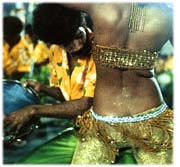

SAMBA
| "clara nunes" >> | recommendations • brasil guide • pryngo guide • contact pryngo • amazon.com | |
 |

SAMBA |
|
 |
SAMBA ANTHOLOGIES FOR LONG, HOT EVENINGS "Let us commit a sin/spread open, sweaty, all steamy," sings Chico Buarque and he might have been thinking of samba. Take your right foot back half a step, put your left foot forward a quarter step, and bring your right foot back. Start again but with opposite feet and you have the basic samba step down. Now do it very quickly without moving your upper body but while writhing your buttocks furiously. Repeat for joyous hours and wear bright colors. Samba is apparently an invention of Rio because of the influx of freed slaves from Bahia after emancipation in 1888. A woman named Tia Ciata from Salvador was known as quite the hostess, and a circle of musicians gathered there at the turn of the century. The result was a 2/4 meter rhythm with an accent on the second beat and syncopated lines of cross-rhythms and melody. The first recorded song generally designated a samba, "Pelo Telefone" of 1917, had been cobbled together at Tia Ciata's. The most successful of this generation of sambistas were Pixinguinha and Sinhô. The next generation proved the 1930's to be the onset of the golden age of samba. The form was perfected by Noel Rosa, Ary Barroso, and Dorival Caymmi for the middle class with sophisticated orchestrations. This squeaky-clean version was dubbed samba-canção. It was this version that Carmen Miranda took to Hollywood and the rest of the world. The main fact of life for the sambista is carnaval. Each year, the public's insatiable appetite for new festival season numbers has generated wave after wave of innovative tunes. In fact, songs were dubbed carnaval or middle-of-the-year sambas. Because the purpose of the pre-Lent festival is to turn the social order upside-down, so the lyrics are often satyrical and evocative of the season's ancient and earthy Dionysian roots. The rhythm section of samba groups is the bateria. Dancers and musicians match the theme of their samba school's annual song in movement and costume. Multimillion dollar productions on and off floats have become the norm in Rio since the late 1970s, although purists have splintered off to less commercialized venues than the enormous sambadrome there. The second golden age of samba came a decade after the onset of bossa nova. The 1960's saw the emergence of Paulinho da Viola and Martinho da Vila, and the 1970s saw the ascension of Clara Nunes, Beth Carvalho, and Agepê. A form of samba called pagode was announced by the record companies, but in fact it was simply a slight shift in instrumentation but the rhythm was pure samba. |
|
 |
 |
|
 |
 |
|
|
BRAZIL CLASSICS 2: O SAMBA, various artists SAMBA BRASIL, various artists CORES DO BRASIL 2: SAMBA, various artists BRAZIL SAMBA ROOTS, various artists SAMBA!, various artists GRANDES MESTRES DO SAMBA, various artists MUSIC OF ARY BARROSO, various artists |
||
|
|
||
|
SAMBA: RESISTANCE IN MOTION, Barbara Browning SAMBA, Alma Guillermoprieto WHY IS THIS COUNTRY DANCING?, John Krich |
||
 |
 |
|
 |
 |
|